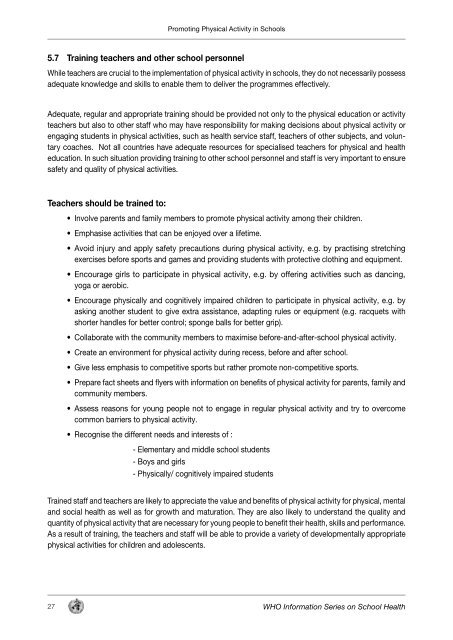WHO INFORMATION SERIES ON SCHOOL HEALTH ... - PAHO/WHO
WHO INFORMATION SERIES ON SCHOOL HEALTH ... - PAHO/WHO
WHO INFORMATION SERIES ON SCHOOL HEALTH ... - PAHO/WHO
You also want an ePaper? Increase the reach of your titles
YUMPU automatically turns print PDFs into web optimized ePapers that Google loves.
27<br />
Promoting Physical Activity in Schools<br />
5.7 Training teachers and other school personnel<br />
While teachers are crucial to the implementation of physical activity in schools, they do not necessarily possess<br />
adequate knowledge and skills to enable them to deliver the programmes effectively.<br />
Adequate, regular and appropriate training should be provided not only to the physical education or activity<br />
teachers but also to other staff who may have responsibility for making decisions about physical activity or<br />
engaging students in physical activities, such as health service staff, teachers of other subjects, and voluntary<br />
coaches. Not all countries have adequate resources for specialised teachers for physical and health<br />
education. In such situation providing training to other school personnel and staff is very important to ensure<br />
safety and quality of physical activities.<br />
Teachers should be trained to:<br />
• Involve parents and family members to promote physical activity among their children.<br />
• Emphasise activities that can be enjoyed over a lifetime.<br />
• Avoid injury and apply safety precautions during physical activity, e.g. by practising stretching<br />
exercises before sports and games and providing students with protective clothing and equipment.<br />
• Encourage girls to participate in physical activity, e.g. by offering activities such as dancing,<br />
yoga or aerobic.<br />
• Encourage physically and cognitively impaired children to participate in physical activity, e.g. by<br />
asking another student to give extra assistance, adapting rules or equipment (e.g. racquets with<br />
shorter handles for better control; sponge balls for better grip).<br />
• Collaborate with the community members to maximise before-and-after-school physical activity.<br />
• Create an environment for physical activity during recess, before and after school.<br />
• Give less emphasis to competitive sports but rather promote non-competitive sports.<br />
• Prepare fact sheets and flyers with information on benefits of physical activity for parents, family and<br />
community members.<br />
• Assess reasons for young people not to engage in regular physical activity and try to overcome<br />
common barriers to physical activity.<br />
• Recognise the different needs and interests of :<br />
- Elementary and middle school students<br />
- Boys and girls<br />
- Physically/ cognitively impaired students<br />
Trained staff and teachers are likely to appreciate the value and benefits of physical activity for physical, mental<br />
and social health as well as for growth and maturation. They are also likely to understand the quality and<br />
quantity of physical activity that are necessary for young people to benefit their health, skills and performance.<br />
As a result of training, the teachers and staff will be able to provide a variety of developmentally appropriate<br />
physical activities for children and adolescents.<br />
<strong>WHO</strong> Information Series on School Health

















